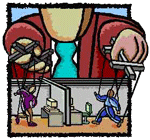|
Six Sigma/Continuous
Improvement
Quality and Value
Value
Businesses add value for customers. To
add value many processes are used. These processes are
often sequential. Few processes are 100% efficient.
Most managers we have talked to report the process efficiency
is between 90% and 99%. The average process efficiency
is about 95%. If the business has a system that has
5 sequential processes of 95% efficiency the overall
efficiency is 77% (multiply 95% by 95% by 95% by 95%
by 95%). 23% of the company's money is lost through
waste. If your business has expenses of $10,000,000
per year $2,300,000 is does nothing for you.
An effective way to get this money back
is to make an effort to improve quality of products,
services, and processes. The improvement will cost a
little money. The returns will be much greater than
the expenditure.
In this article we describe the necessary
steps to implement a company wide quality system. The
most important feature of the whole system described
is the commitment by owners and top management to improvement.
The commitment must be maintained day after day, year
after year.
The steps to improvement have been described
for many decades. They have been known by different
names. The most common popular ones are: Continuous
Improvement, Total Quality Management, and Six Sigma.
Qualitiqua is qualified to help businesses implement
modern quality systems under any of these banners.
Organizing for Quality
The old way
 Many
businesses are organized as a vertical hierarchy. This
model is easy to understand but it has some serious
deficiencies. The deficiencies tend to arise from the
fact that the most important customer in the hierarchy
is the immediate supervisor. If employees want to get
ahead, or in some cases keep their job, they must make
sure the supervisor is happy with them. Less thought
is give to the company's customers or the next person
in the value added chain that uses the output of their
effort. Many
businesses are organized as a vertical hierarchy. This
model is easy to understand but it has some serious
deficiencies. The deficiencies tend to arise from the
fact that the most important customer in the hierarchy
is the immediate supervisor. If employees want to get
ahead, or in some cases keep their job, they must make
sure the supervisor is happy with them. Less thought
is give to the company's customers or the next person
in the value added chain that uses the output of their
effort.
To overcome these deficiencies a new way
of organizing for quality is needed
Another common feature of the vertical
hierarchy is that management has the brains while the
employees provide the brawn. This is a manipulative,
top down approach that does not value employee participation.
The vertical organization often has a large middle management
structure. To get ahead in the hierarchy managers need
to have larger staff (more people reporting to the manager
increases the amount of money they receive), creating
a bloated bureaucracy. Employees have to only get along
with their immediate manager to get ahead; they are
often not focused on meeting customer's needs and expectations.
The new way
 The
owners and senior managers establish policies that demand
employee participation and team work in the running
of the organization. For small organizations the owner
and senior management may be the same person(s). The
focus of the organization is meeting or exceeding customer's
needs and expectations. The requirement for middle managers
and other non-value added work is reduced leading to
lower internal cost and higher profitability. Employees
are customer oriented and involved in the value added
chain. The
owners and senior managers establish policies that demand
employee participation and team work in the running
of the organization. For small organizations the owner
and senior management may be the same person(s). The
focus of the organization is meeting or exceeding customer's
needs and expectations. The requirement for middle managers
and other non-value added work is reduced leading to
lower internal cost and higher profitability. Employees
are customer oriented and involved in the value added
chain.
New priorities
In the new organization people will have
different priorities to focus on.
The new organizational structure has three
main parts. They are: the owners or the board of directors,
the Quality Council, and the Improvement Teams. Senior
management is still with setting quality policies and
implementing them on a day-to-day basis.
Owners and Directors
 The
owners or directors have a pot of money they want to
increase. To increase the pot of money, market share
needs to increase and internal costs need to be reduced.
Many organizations found that improving quality of both
products and internal processes as a very effective
way of meeting these two requirements. In other words
the organization needs to make quality a priority and
part of its vision. The
owners or directors have a pot of money they want to
increase. To increase the pot of money, market share
needs to increase and internal costs need to be reduced.
Many organizations found that improving quality of both
products and internal processes as a very effective
way of meeting these two requirements. In other words
the organization needs to make quality a priority and
part of its vision.
Vision
 Where
the owners sees the organization going. For example
the owners decide they want to increase market share
from 25% to 35%. Where
the owners sees the organization going. For example
the owners decide they want to increase market share
from 25% to 35%.
Senior management
 Implements
the quality system that is based on continuous improvement
to increase market share and reduce internal costs.
Champions' improvement activities and teams for the
organization. Provides owners and directors with information
about how the quality system is working. Implements
the quality system that is based on continuous improvement
to increase market share and reduce internal costs.
Champions' improvement activities and teams for the
organization. Provides owners and directors with information
about how the quality system is working.
Mission
 The
way management is going to accomplish the vision. For
example the organization's mission becomes improving
quality. The mission will lead to a lower priced product
that will attract higher volume thereby increasing market
share. The
way management is going to accomplish the vision. For
example the organization's mission becomes improving
quality. The mission will lead to a lower priced product
that will attract higher volume thereby increasing market
share.
Constancy of Purpose
Each day management needs to take action
to ensure quality improvement becomes a way of life
for the organization.
Quality Council
 In
the new organization the Quality Council is a key element.
The council is an agent of the owners or board of directors.
Participants are: at least one board member or the owner,
senior management, representatives of important functions
in the organization. For example the council can consist
of: In
the new organization the Quality Council is a key element.
The council is an agent of the owners or board of directors.
Participants are: at least one board member or the owner,
senior management, representatives of important functions
in the organization. For example the council can consist
of:
o The chairman or owner,
o The president if different from the owner,
o A senior marketing manager,
o A senior design manager,
o A senior production or operations manager,
o A senior quality manager,
o A senior purchasing manager,
o A senior sales manager, and
o A senior accounting manager.
This council is responsible for overseeing
the quality system for the organization with particular
emphasis on improvement. One of the major routes for
improvement is the Improvement Team. The council tracks
and supports all Improvement Teams.
The council formulates a quality strategy
that has specific marketing and financial objectives
that can be used measure the success of the quality
improvement system. The financial objectives should
include market share and cost reduction objectives.
Quality strategy
Important topics for the quality strategy
are:
o Determining the cost of quality,
o Establishing and maintaining a system of continuous
improvement by having teams of people work on making
many small improvements,
o Define stretch goals for the teams to improve performance
beyond the current level,
o Find processes that are in need or major upgrade and
re-engineer them to achieve a major breakthrough in
performance,
o Determining the education and training requirements
for the organization's members,
o Get everyone involved in quality, and
o Adjusting the reward and compensation package to encourage
a quality mind set in all people in the organization.
Cost of quality
Determine how much the system is costing
to achieve the current level of quality. In many organizations
tracking internal costs needs to be done in a new way.
The cost of prevention, appraisal, and failure need
to be assessed. Most organizations do not have a way
of assessing quality costs. Cost of quality reporting
gives management a tool to set quality improvement priorities.
A large part of preventions costs is the
cost of planning for quality and training. Many organizations
find that by having a small increase in this area, especially
planning, reduction in appraisal and failure costs occur.
Appraisal costs are the costs of testing
and checking activities.
Failure costs are the costs of doing things
over again because they were not done right the first
time. This cost included the cost of errors made by
design, purchasing, marketing, or sales. It is not restricted
to the costs of poor service delivery or manufacturing
defects.
Continuous improvement
Get everyone involved in improving processes
in small ways every day. Improvement Teams are formed
to solve specific problems. They typically last less
than two months from inception to dissolution. Often
the teams select the topics to work on. A supervisor
may also decide to establish an Improvement Team in
his or her work area. The Quality Council manages these
teams.
Stretch goals
Sometimes it the Improvement Team sets
its goals too low. In that case the Quality Council
will ask them to raise the bar to get a boost in performance.
Breakthrough
Occasionally the Quality Council sees
the need to achieve a significant change in the performance
level of a particular process. The new process is radically
different from the current process that it is completely
re-engineered and a break through in performance is
achieved.
Rewards
To help people understand what is important
to the owner or directors the reward and compensation
system needs to be compatible with the new way of managing
the organization. The system needs to be designed to
encourage teamwork and ensure all people participate
in the rewards of the improvement system. Managers need
to have compensation related to performance of teams
they are championing.
Improvement
Teams
 Improvement
Teams are teams of people who are trained in improvement
methods using data. These teams improve the performance
of specific processes, or parts of processes. They exist
only as long as it takes to improve the process. Improvement
Teams are teams of people who are trained in improvement
methods using data. These teams improve the performance
of specific processes, or parts of processes. They exist
only as long as it takes to improve the process.
Characteristics of these teams are:
o The team has a champion,
o Members know how to work as a team.
o Members are trained to use analysis to improve processes,
and
o Members are involved in the improvement process.
Champions
Senior managers who take a direct interest
in the activities of improvement teams become champions.
They support the team with the required resources and
help them with presentations to senior management or
the board.
Teamwork
Most improvements can only come about
through the activities of the team of people who are
involved in the processes they are trying to improve.
I people have not worked in a teamwork environment they
will need to be trained in teams work. This holds for
people at all levels in the organization.
Analysis
To analyze process performance teams
members need to be trained in:
o Defining the scope of the improvement,
o Measuring the process in question,
o Analyzing the data,
o Improving the process, and
o Establishing the controls for the improved process.
Involvement
Eventually, as many people as possible
need to be involved in improvement teams. Participation
is expected from all in the organization.
Improvement
 The
following topics are often found to be important places
to start improvement activities. The
following topics are often found to be important places
to start improvement activities.
Vendors
Find lowest cost vendors. Lowest cost
supplier is not lowest price supplier. The best supplier
is one that the total of the price and any costs your
organization incurs due to problems with the suppliers
product are the least. Two examples of extra costs are:
receiving inspection, and higher final inspection costs
and rework costs when supplier product is causing rejected
final product. These extra cost need minimizing.
Accounting
The cost accounting system needs to be
adjusted to collect the cost of quality data and then
provide management with reports on the cost of quality.
The cost of quality system allows the Quality Council
to better-set priorities.
First pass yield
An aim of the quality system can be to
ensure an acceptable or service product is produced
first time, all of the time. A measure of process performance
is the first pass yield; what percentage of the product
passes all inspection points the first time? Organization
needs to know this number to be able to focus on improvement.
Design Cycle Time
Reduction
Reducing the time taken to design and
introduce products a very important with respect to
market position, this time is the design cycle time.
In particular it is very important to involve operations
staff in the design process since they are required
to economically produce the items designed. Usually
reducing design cycle time requires a breakthrough in
performance.
Breakthrough
Re-engineering
Looking at process
from a completely different perspective and redesigning
it to more efficient. From a quality perspective it
is not downsizing by changing the budget.
Innovation
To remain competitive
organizations need to continually be innovative with
new products, services and processes to deliver the
products and services.
Education and training
 Skill
sets Skill
sets
As processes are improved employee skill
sets will need to be updated. The skill requirements
will be documented and a training program established.
Updating
skills
Staff will need to attend all the training
given to keep their skills up to date.
Management Commitment
To make the whole system work properly
requires management commitment. The commitment comes
from the owner, or the board, and senior management.
Commitment comes by promoting the importance of quality
improvement as a way of life in the organization day
after day. It is not the management fad of the month.
Rewarding teams that successfully improve
processes becomes a way of life. The rewards may be
financial as well as recognition for a job well done.
Teams are also rewarded when: their ideas are accepted
and implemented; and when requests for capital expenditure
are accepted, with proper justification, by senior management.
|



